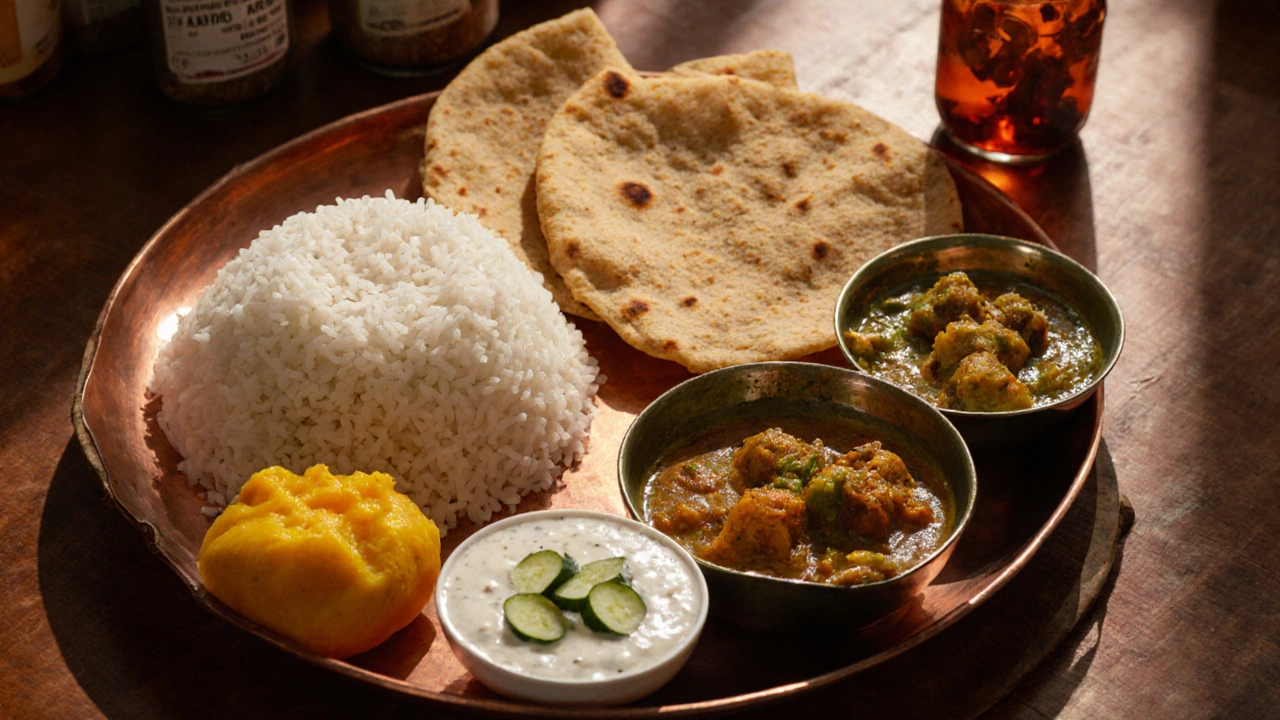Indian Vegetarian Meal: Recipes, Health Tips & More
When talking about Indian vegetarian meal, a plate that blends spices, legumes, grains, and fresh vegetables to deliver flavor and nutrition. Also known as veg Indian cuisine, it serves both comfort and health goals for millions of households.
A core component of any dal, split pulses cooked with aromatics and spices, is its protein punch. Dal pairs naturally with roti, a whole‑wheat flatbread that offers fiber and a soft canvas for scooping up sauces. Together they form the staple base for countless regional variations. Adding paneer, fresh Indian cheese prized for its mild taste and firm texture, introduces calcium and a satisfying bite that rounds out the meal.
Why Indian Vegetarian Meals Matter
These meals aren’t just tasty; they’re a smart way to meet daily nutrient needs. The combination of dal’s iron, roti’s complex carbs, and paneer’s protein creates a balanced macro profile without heavy animal fats. That’s why dietitians often point to Indian vegetarian meals as heart‑friendly options. Plus, the spice blend—turmeric, cumin, coriander—adds antioxidants that support digestion and reduce inflammation.
Cooking methods also play a role. For instance, soaking dal before simmering cuts cooking time and improves digestibility, while rolling roti thin and cooking it on a hot tawa creates the puff‑up needed for a light texture. Paneer benefits from gentle simmering in a gravy; over‑cooking makes it rubbery, a common pitfall you’ll want to avoid.
Beyond the basics, regional flavors expand the menu. South Indian meals might feature dosa batter spiked with a pinch of soda for crispness, while North Indian plates often include rich, tomato‑based chutneys that add tang and depth. Each side dish, whether it’s a tangy mango chutney or a cooling raita, influences the overall taste experience and can boost the meal’s vitamin content.
When you plan an Indian vegetarian meal, consider the occasion. A quick weekday dinner could rely on a simple dal‑roti combo with a dollop of butter, whereas a weekend feast might showcase paneer tikka, mixed vegetable sabzi, and a variety of chutneys for texture contrast. Adjusting spice levels—using milder chilies or swapping in garam masala—lets you cater to sensitive palates without sacrificing authenticity.
Health‑focused eaters often wonder about calorie counts. By steaming vegetables instead of deep‑frying, using low‑fat cooking oil, and moderating ghee, you can keep the dish under 500 calories per serving while still delivering satiety. Pairing the meal with a side of cucumber salad adds hydration and crunch, rounding out the nutritional profile.
In the kitchen, a few tools make the process smoother: a sturdy pressure cooker for quick dal, a cast‑iron tawa for perfect roti puff, and a non‑stick pan for paneer that won’t stick. Mastering these basics unlocks the ability to experiment with new recipes—think paneer‑filled parathas or dal‑based soups that blend comfort with innovation.
Below you’ll find a curated list of articles that dive deeper into each of these elements. From soda tricks for dosa batter to exact dal cooking times, from fixing rubbery paneer to sweet chutney pairings, the collection equips you with practical tips and step‑by‑step guides. Ready to level up your Indian vegetarian meals? Let’s explore the resources that follow.

What Is an Indian Vegetarian Meal? A Complete Guide
Explore the makeup of a classic Indian vegetarian meal, from staples and dals to regional twists, health benefits, and how to build a balanced thali.
- Chutney Recipes (13)
- Healthy Living (12)
- General (11)
- Easy Indian Recipes (9)
- Chicken Curry Recipes (9)
- Paneer Recipes (8)
- Healthy Indian Snacks (8)
- Dal Recipes (7)
- Street Food (7)
- Dosa Recipes (7)
-
British Chutney Explained: Its Flavors, Origins, and Modern Twists
6 Aug 2025 -
The Secret Behind Rinsing Lentils: Unlocking Flavor and Nutrition
15 Dec 2024 -
How to Fix Vinegary Homemade Chutney and Achieve Perfect Flavor
1 Feb 2025 -
What Makes Chicken Curry Taste Better?
20 Mar 2025 -
What Do Native American Indians Eat for Breakfast?
11 Apr 2025
8.10.25
Kaia Binari
0